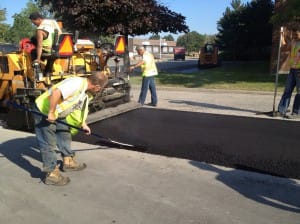The smart Trick of A1 Professional Asphalt & Sealing Llc That Nobody is Discussing
The smart Trick of A1 Professional Asphalt & Sealing Llc That Nobody is Discussing
Blog Article
A1 Professional Asphalt & Sealing Llc Things To Know Before You Buy
Table of ContentsA1 Professional Asphalt & Sealing Llc Fundamentals Explained4 Simple Techniques For A1 Professional Asphalt & Sealing LlcThings about A1 Professional Asphalt & Sealing LlcThe A1 Professional Asphalt & Sealing Llc StatementsSome Known Incorrect Statements About A1 Professional Asphalt & Sealing Llc

The oil in an auto engine is not simply oil. The REOB includes all the additives that were in the waste oil as well as the wear steels from the engine (mostly iron and copper).
Nevertheless, by making numerous blends utilizing various REOB samples and various asphalt binders, the variations mostly can be averaged out. Numerous States supplied examples of well-known REOB make-up to TFHRC scientists, that analyzed the examples to compare the percent of added (understood) REOB to the located (checked) amount. The analyses showed an equivalent percentage of added and discovered REOB.
How A1 Professional Asphalt & Sealing Llc can Save You Time, Stress, and Money.
None of those States understood that the asphalt they were purchasing included REOB. One State insisted its examples had no REOB - https://experiment.com/users/jtally.
Of the 1,532 samples tested, 12 percent consisted of REOB, and some included substantially high degrees of it at 1020 percent. The highest degree was 34 percent in a sample from Texas, which TxDOT had actually utilized in a patching compound. This screening additionally exposed the existence of phosphoric acid in 11 percent of the samples, and 2 percent included ground tire rubber.
2 years back at TRB's yearly meeting, the Federal scientists held an REOB workshop and provided the searchings for of their laboratory assessments to a standing room-only group. Although some companies do not particularly ban REOB, they do impose physical tests that prevent its useeffectively a restriction. asphalt repairs. Others do not outlaw it by specification, yet have arrangements with asphalt providers to avoid using REOB
All About A1 Professional Asphalt & Sealing Llc
A handful do allow REOB, some within particular limitations. Ohio and Texas limit degrees to less than 5 percent of the asphalt. To create a reliable test approach that all States can make use of, the TFHRC researchers set up a round-robin examination plan. The individuals are 11 State highway agencies (Illinois, Massachusetts, Minnesota, Mississippi, Montana, North Carolina, Oklahoma, South Carolina, Texas, Vermont, and Wyoming), 2 independent testing labs, the Ministry of Transport in Ontario, Queen's College in Ontario, and an Ontario paving service provider.
The participants are examining the samples separately using the standards provided by the TFHRC scientists. The result will certainly be a suggested AASHTO test approach that any type of State can embrace and make use of.
The pavement with REOB, which is located 0.6 mile (1 kilometer) from the pavement without REOB, has similar subgrade, website traffic thickness, and climate. The section of Highway655 with 5 to 10 percent REOB showed significant fracturing. In this example, the presence of REOB was the recognized reason of splitting at a reduced temperatures.
"In our experience in copyright, also small amounts of 23 percent can be a problem." An area of examination pavement in Minnesota (MN1-4) located to consist of REOB additionally broke too soon. The pavement executed well for the initial 3 to 4 years, however after that started to break. This pavement is likewise based on low temperature levels.
The Definitive Guide for A1 Professional Asphalt & Sealing Llc
The tests were not extensive, but they revealed that at levels of 6 percent or more, the tensile stamina of the asphalt went down substantially. At a degree of 3.5 percent REOB, the variant in the physical test techniques was higher than the effect of REOB. It was challenging for scientists to assess whether REOB was existing. https://alasphaltseal.wixsite.com/a1asphaltseal/post/a1-professional-asphalt-repairs-enhancing-roads-with-excellence.

One binder parameter taken into consideration is the distinction between the reduced temperature crucial requirements temperature level for rigidity (S) in the bending beam rheometer and the flexing light beam rheometer creep slope (m-value) noted as Tcritical. TC = TC (S) TC (m-value). Evaluation of this specification is still ongoing. 2 independent study groups, one from AASHTO and the various other from the Asphalt Institute, ended that even more research is needed on the use of REOB in asphalt.
Formerly, all asphalt testing determined engineering residential properties such as tightness. These tests do not show what materials had actually been included to the asphalt. One sample obtained throughout the TFHRC research had a very unusual evaluation. The example had visit the website the adhering to test outcomes: Superpave PG 64-28 with a high temperature grade of 67.3 Tcritical on the bending light beam rheometer was 6.7 levels Celsius.

9 Easy Facts About A1 Professional Asphalt & Sealing Llc Shown
These outcomes show there are weaknesses in the standard design testing methods that might be exploited. The manufacturer may have a financial benefit and the product passes all the standardized examinations, but the product might not be beneficial to making certain lasting performance. To address this concern and the growth of new asphalt additives and extenders, TFHRC is beginning a research study program to use portable spectroscopic devices, x-ray fluorescence spectroscopy, and Fourier change infrared spectroscopy to allow evaluations to be performed in the area instead than needing to take examples back to the laboratory.
Report this page